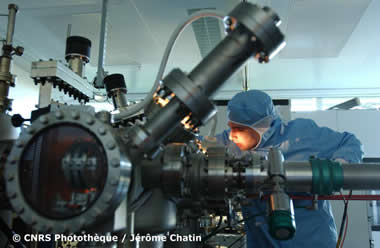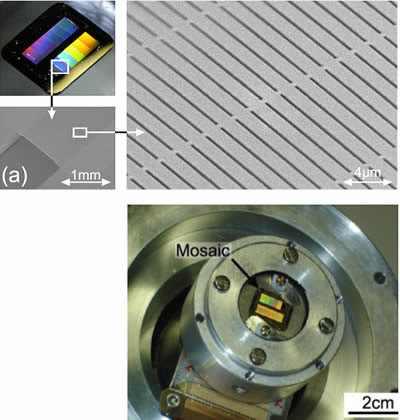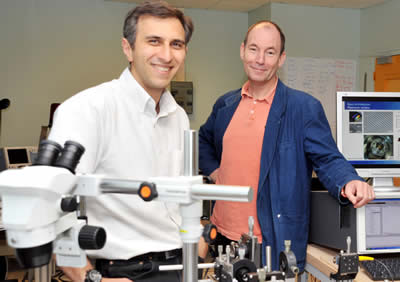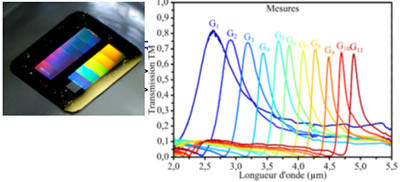Le Laboratoire de Photonique et de Nanostructures (CNRS/LPN), et l'Onera/DOTA (optique), unissent leurs forces, leurs connaissances et leurs équipes autour de la recherche sur la nanophotonique et ses applications.

The clean room of the LPN, where the nanostructures for the ONERA-LPN team research are manufactured
Since 2005, the CNRS, via its Photonics and Nanostructure Laboratory (LPN), and ONERA, through part of the Innovation Design in Optics (CIO) team of the Theoretical and Applied Optics Department, have joined forces and teams, pooling their knowledge to conduct research in nanophotonics and its applications.
Details of this original approach that makes it possible to develop innovative new technologies, with Riad Haidar, researcher at ONERA (Palaiseau) and Jean-Luc Pelouard, head of the “Device Physics” group at the CNRS/LPN (Marcoussis).
Interview
What was the origin of this partnership in 2005? What is its objective?
Riad Haidar: The idea of this approach was simple: to find a common perimeter for both of our entities so that we can share our skills in a very important field, which we both have worked on to different degrees: nanophotonics and its applications.
From the start we wanted to give this partnership both a quite precise goal – to develop new technologies as fast as possible – and a unique approach in the French scientific world – to fuel our joint discussions with applicative needs (e.g. the detection of polluting gas, the tracing of human activity on a scene, etc.) and by the new possibilities offered by the progress of knowledge and technologies (for example, sub-wavelength optical nano-resonators). So, one of our first achievements was a mosaic of nanostructured metal filters for multispectral infra-red imagery (See the Vitrail textbox).

Detail of the Vitrail project infra-red camera filter mosaic
Jean-Luc Pelouard: From the beginning the purpose of this collaboration has been to follow as effectively as possible the background movement that constituted this research subject, and still constitutes it today, creating a truly integrated ONERA-LPN team. This with, as Riad has said, an intangible principle: to trace out the entire development chain, from the beginning of the study, in order to envisage that the same high-tech object will be used to demonstrate physical effects before being integrated into a complex system (for example an infra-red camera), in order to show its applicative potential. The gain in time is thus considerable.
How does this LPN-ONERA team work on a daily basis?
JLP: First of all, we have a unique environment, two laboratories equipped with resources that are rare, in a technologically advanced sector (nanophotonics and optics), which is growing but which scientists have been working on for barely more than ten years! These significant resources, which are essential for rapid progress, are shared every day, enabling us to tackle “hot” subjects and so develop innovations at an intensive pace.
RH: Today, this partnership includes 3 permanent employees of ONERA, 5 permanent employees of the LPN and about fifteen doctorate and post-doctorate students. While Jean-Luc and I remain affiliated to our original organizations, the non-permanent employees are both from ONERA and LPN.
We all work, without distinction, in the clean rooms of the LPN in Marcoussis, or at the ONERA site in Palaiseau, according to research needs and those of the many meetings that we organize. It is a real joint scientific adventure, even though the two laboratories have not merged: but the doors are open and there are daily exchanges and continuous sharing.
There is no doubt that we form a true team, united by the same objectives. And, as astonishing as it may seem, we understand each other perfectly, even though, it’s true, we did not speak the same scientific language, at the beginning at least: some preferred to express optical transitions in electron-volts and others in microns; it was thus necessary to find a common vocabulary, but these small differences are also what makes things richer.

Riad Haidar and Jean-Luc Pelouard in one of the laboratories of their joint team at the ONERA center in Palaiseau
How do you explain your success with doctorate students? so many of them are knocking on your door
JLP: It is true that many laboratories complain of a lack of doctorate students. We do not have this worry, and for several reasons: first of all, we offer missions involving them both upstream and downstream, on a completely topical subject.
So when they leave us, they will not have any difficulty in finding work. Better still, they will be encouraged to become entrepreneurs, at the end of their thesis, with a demonstrator “in their briefcase”, a valuable asset allowing them to present their start-up and, in the long term, if everything goes well, to sell to industry the application that we will have patented and developed together. Some have already done so. Speaking of patents, did you know that in 2010 alone our team submitted no less than 3!
RH: Of course, on the other hand, we are very demanding in the recruitment of these doctorate students. We look for really pro-active candidates, independent, creative, mobile (both geographically speaking, and also as regards work subjects) and who are not afraid to take on a heavy workload.
But the motivation and enthusiasm of these people has up to now been such that we have no regrets regarding our choices. I can say that within this team there is a kind of alchemy, created between hard science and applicative technology, and between the very varied profiles (opticians oriented towards applied physics, plasma theorists, etc.). This alchemy motivates us all to achieve our goals as fast as possible and go beyond our limits.
Vitrail: a concrete example of an “upstream/downstream” project
It is not by chance that this project on plasmonic interaction problems, carried out by an integrated ONERA-LPN team, was called Vitrail. It is a way of paying homage to the unique know-how of the master-glass-makers of the Middle Ages, who perfectly mastered the insertion of metal nano-particles in glass and who, in essence, were doing plasmonics without knowing it.

A VITRAIL project filter mosaic and the corresponding spectra
From the start, within the team, this study on filter mosaics was done so that in the long term the object can be integrated into an application, namely an infra-red camera. This is what forms the “DNA” of this ONERA-LPN collaboration: the fundamental principles are never separated from the application. “We did not dive head first, blindly, into this research subject” says Riad Haider. “On the contrary, we had clearly identified this requirement in our exchanges with the DGA*.”
* DGA: Direction Générale de l'Armement (French Defense Procurement Agency)
Is this an exportable partnership?
This profitable and complementary collaboration between ONERA and the LPN unquestionably creates a domino effect, as Riad Haidar explains: “The CIO is going to collaborate, on a similar model, with the IES in Montpellier. We have also recently presented our development approach to the laboratories of excellence (labex) of Saclay, who have said that they are interested.”
Jean-Luc Pelouard confirms: “Several laboratories of excellence think that our operating process, leading to development with a very short cycle, is exemplary. It is perhaps not applicable in exactly the same way to all subjects, but it is without a doubt exportable!”
The issue will become increasingly topical, given that research in the field of nanotechnology applied to photonics and optics is an activity that is currently very active.
In addition, as from this year, the ONERA-LPN team has widened its research to the problem of light sources. “These subjects are vast and inter-connected. It is not possible for everyone to be working independently, each in his own corner. We think that it will be very beneficial to widen the circle and benefit from each other’s skills”, concludes Riad Haidar.
* Onera/DOTA : département Optique théorique et appliquée
** CNRS/LPN : laboratoire de photonique et de nanostructures




